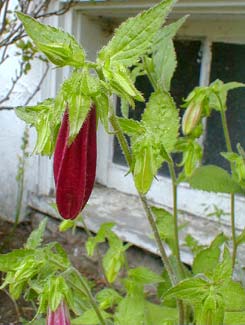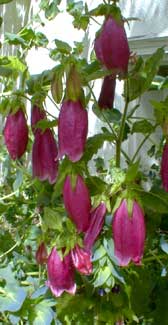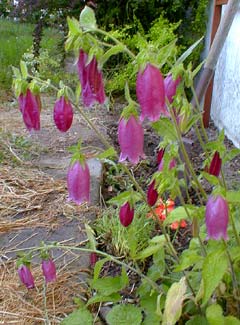
'Cherry Bells'
Spotted Bellflower,
aka Chinese Rampion
"As I wandered the forest,
The green leaves among,
I heard a Wild Flower
Singing a song.
"I slept in the earth
In the silent night,
I murmured my fears
And I felt delight."
-William Blake
(1757-1827)
(1757-1827)
Campanula punctata 'Cherry Bells' produces a half-foot to full-foot tall clump of basal leaves that can spread quite rapidly into a dense groundcover. From these leaves there arise two- to three-foot stems hung with white-fringed cherry-red two-inch bellflowers, spotted on the interior.
 The blossoms, loved by hummingbirds, can appear as early as May but are especially numerous in June, with rebloom deep into autumn, until first frost or until winter sends the clump into dormancy. The photos on this page were shot in June, a bud early in the month, the flowers later in the month.
The blossoms, loved by hummingbirds, can appear as early as May but are especially numerous in June, with rebloom deep into autumn, until first frost or until winter sends the clump into dormancy. The photos on this page were shot in June, a bud early in the month, the flowers later in the month.It sometimes suffers summer damage if not kept moist, then has another flourish of gorgeous leaves with fewer flowers September through early November. It entirely dies back in winter & waits comfortably for spring to return, being extremely cold-hardy (minus 30 to 20 degrees F). Its leaves reemerge in March. As an edible campanula, those first young leaves are especially good in salads.
The Asian species is found from Siberia through China to Japan. In Japan, where it grows at the shadeline under trees on forested hillsides, it is called Hotaru-bukuro, which roughly means "Bag with Fireflies Inside." It can be regarded a "bright shade" flower needing some protection from sunburn but not wanting to be too deeply in the shade. The farther north it is grown the more sun it requires; it will not do well in zones with very warm summers.
 The specific cultivar 'Cherry Bells' was developed in Japan. It is really one of the most pleasing campanulas for tidiness of basal leaves & beauty & colorfulness of large longlasting pendulous flowers. The stems have an appealing flowing tilt which does not look floppy, but permits the "bells" to dangle naturally, so that staking is never required.
The specific cultivar 'Cherry Bells' was developed in Japan. It is really one of the most pleasing campanulas for tidiness of basal leaves & beauty & colorfulness of large longlasting pendulous flowers. The stems have an appealing flowing tilt which does not look floppy, but permits the "bells" to dangle naturally, so that staking is never required.Its one drawback is its aggressive spread by underground rhizomes, that will take over ground from less aggressive perennials. When the clump becomes larger than desired, it can be dug up & divided, which will probably be necessary every third year. If it is dug up & moved altogether, invariably it reappears in its previoius location, from fragments of its rhizomes.
Despite its potential for aggression, some gardeners report that it died out of their gardens suddenly & without evident reason. I suspect the reason for this would have to be due to it easily feeling "hemmed in" by surrounding droughty soils; it will not spread without persistent moisture, & then if the confined clump experiences a harsh dry period, it can experience sudden death.
It tends not to spread outside watering zones, as it seriously dislikes entirely drying out. It can persist in a very restrained manner if it does occasionally dry out, but will be perpetually stressed & at risk of fading from the garden.
But in conditions even close to its preferences, it will even reseed itself at some distance, to the point of nuisance, yet is so pleasant it's worth digging up volunteers & potting them to trade with other gardeners. Or seedlings can be nipped in the bud so to speak, by regularly taking the freshcut flowers for bouquets, or by deadheading spent flowers before they go to seed.
Campanula punctata x trachelium 'Sarastro'